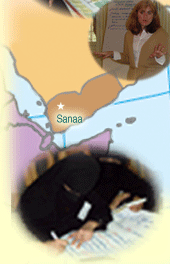
Connecting Midwives and Communities
A widely dispersed population, one of the world’s highest fertility rates, and high ratios of infant and maternal mortality signal the acute need for comprehensive health services—including community-level reproductive health (RH) providers—in the Republic of Yemen. Female RH providers are especially in demand, as cultural and religious traditions restrict males from offering many key RH services. In 1999, collaborating with Yemen’s Ministry of Public Health (MOPH), PRIME II conducted a performance needs assessment of a new cadre of community midwives (CMWs) who graduated that year and began work in four governorates. The assessment showed that the CMWs would need additional assistance to perform to expectations, including supportive supervision, on-the-job training through self-directed learning, improved marketing of their services, and licensing and periodic recertification to maintain quality standards.
Interventions to benefit the CMWs were developed and implemented during 2000-2001. The strategy included six self-directed learning modules to offer in-service training for CMWs and a pre-existing cadre, murshidaats; monitoring tools and a job manual for supervisors; the planning and implementation of a performance support system for the CMWs; and a pilot project to license CMWs in two governorates. An evaluation of the project was cancelled for security reasons. During 2004, PRIME II returned to Yemen to carry out a performance needs assessment in collaboration with the MOPH to prepare for expansion of the CMW program in five additional governorates—Marib, Sa’ada, Shabwa, Amran and Al-Jawf.
|











